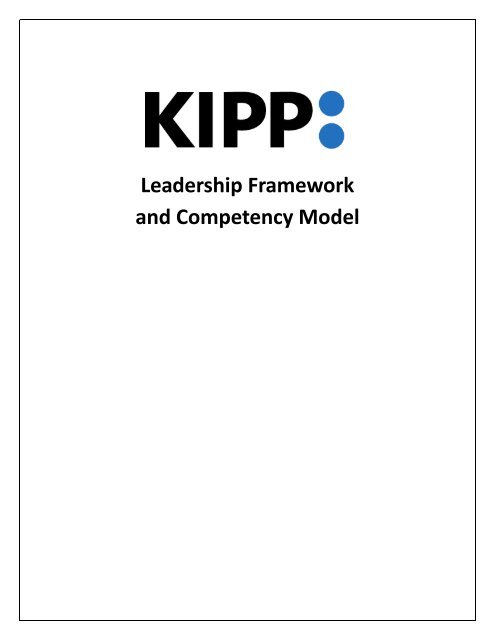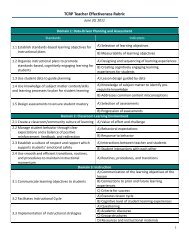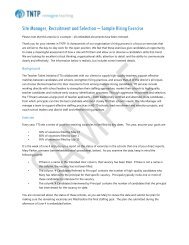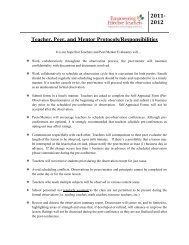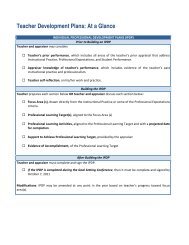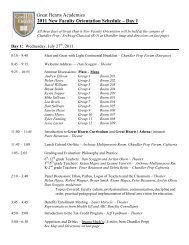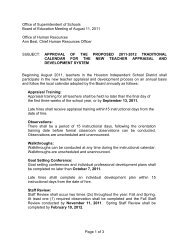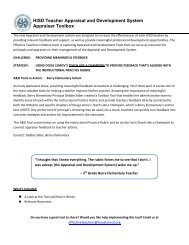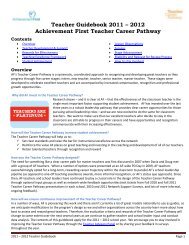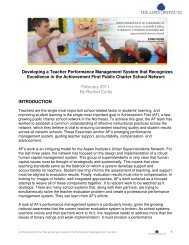KIPP Leadership Framework and Competency Model FINAL - TNTP
KIPP Leadership Framework and Competency Model FINAL - TNTP
KIPP Leadership Framework and Competency Model FINAL - TNTP
You also want an ePaper? Increase the reach of your titles
YUMPU automatically turns print PDFs into web optimized ePapers that Google loves.
<strong>Leadership</strong> <strong>Framework</strong><br />
<strong>and</strong> <strong>Competency</strong> <strong>Model</strong>
Introduction<br />
The <strong>KIPP</strong> <strong>Leadership</strong> <strong>Framework</strong> <strong>and</strong> <strong>Competency</strong> <strong>Model</strong> describes the competencies <strong>and</strong> behaviors<br />
considered most important to the performance of <strong>KIPP</strong> Executive Directors, Principals, Vice Principals/Deans<br />
<strong>and</strong> Grade Level Chairs/other teacher leaders, leaders in our regional shared services teams <strong>and</strong> <strong>KIPP</strong><br />
Foundation staff.<br />
Our leadership framework is the high‐level category architecture that assists in organizing our competencies<br />
<strong>and</strong> showing how those competencies relate to one another. A competency can be defined as “a cluster of<br />
related knowledge, skills <strong>and</strong> attitudes that affects a major part of one’s job (a role or responsibility), that<br />
correlates with performance on the job, that can be measured against well‐accepted st<strong>and</strong>ards, <strong>and</strong> that<br />
can be improved via training <strong>and</strong> development” (Parry, 1996, p.50).<br />
Every competency in this model includes key behaviors that make up the competency. The key behaviors<br />
within each competency describe the actions a leader takes that demonstrate proficiency in that<br />
competency.<br />
This model lays the foundation for several associated tools that will enable us to more effectively select,<br />
develop, evaluate, retain, <strong>and</strong> promote leadership at <strong>KIPP</strong>. <strong>Leadership</strong> development tools associated with<br />
this model include evaluation tools, goal‐setting tools, 360 feedback tools, proficiency <strong>and</strong> leadership<br />
development roadmaps, realistic job preview tools, interview protocols, <strong>and</strong> selection rubrics.<br />
Description of the <strong>Framework</strong> <strong>and</strong> <strong>Competency</strong> <strong>Model</strong><br />
Effective <strong>KIPP</strong> leaders Drive Results, Build Relationships, <strong>and</strong> Manage People. They do so in order to Prove<br />
the Possible for our students. As such, we’ve organized our core framework <strong>and</strong> competencies into these<br />
four categories. Every individual also has critical role‐specific competencies that may vary by role across<br />
regions <strong>and</strong> as you cross from school leadership into regional leadership. Essential competencies such as<br />
Instructional <strong>Leadership</strong> <strong>and</strong> Operations Management fit in this category. The Role‐specific Competencies<br />
category rings the core competencies because these competencies often make up a very visible part of an<br />
individual’s role <strong>and</strong> because they often rely upon many of the underlying core competencies.<br />
The Prove the Possible category <strong>and</strong> Student Focus competency are at the middle of our model, helping to<br />
always center the efforts of our leaders with a constant focus on what’s best for students. The Drive Results<br />
category includes core competencies that are directly associated with the individual’s ability to produce<br />
exceptional outcomes <strong>and</strong> their ability to model <strong>and</strong> support others in producing exceptional outcomes.<br />
The Build Relationships category includes competencies that enable our leaders to work effectively with<br />
others. The Manage People category includes competencies that all leaders must demonstrate to ensure<br />
that staff <strong>and</strong> team performance are excellent. Role‐specific Competencies include specialized knowledge<br />
<strong>and</strong> skills that are extremely important <strong>and</strong> highly visible to some, but not all leadership roles at <strong>KIPP</strong>. For<br />
example <strong>KIPP</strong> Executive Directors <strong>and</strong> Principals must demonstrate operational skills <strong>and</strong> knowledge that<br />
are not required for <strong>KIPP</strong> Grade Level Chairs. This category allows flexibility for regional organizations to<br />
apply this model to Shared Services Team members whose roles may also require essential domain<br />
expertise.<br />
2
Background <strong>and</strong> Research Base<br />
The <strong>KIPP</strong> <strong>Leadership</strong> <strong>Competency</strong> <strong>Model</strong> is both empirically derived <strong>and</strong> heavily research‐based. To create<br />
this model we relied partly upon the practical experience of high performing <strong>KIPP</strong> leaders at all levels <strong>and</strong><br />
those at <strong>KIPP</strong> Foundation who work with those leaders. Through both discussions <strong>and</strong> focus groups, our<br />
leaders offered perspective on what competencies are most important to their effectiveness. Focus groups<br />
validated this model by providing role‐specific examples of every key behavior in the model. We also relied<br />
significantly upon research in the organizational, business, <strong>and</strong> education domains that indicated which<br />
competencies <strong>and</strong> behaviors are most tied to effective leadership, management <strong>and</strong> student achievement.<br />
This research helped us to both prioritize competencies <strong>and</strong> structure the key behaviors that demonstrate<br />
proficiency in those competencies. Appendix A contains a list of the research base that has been referenced<br />
to build this model.<br />
3
PROVE THE POSSIBLE ‐ Student Focus<br />
Key Behaviors: An Effective <strong>KIPP</strong> Leader…<br />
: HIGH EXPECTATIONS. Expresses high expectations for all students, <strong>and</strong> expresses belief in their<br />
potential to complete college <strong>and</strong> succeed in life.<br />
: STUDENT BEST INTERESTS. Seeks to underst<strong>and</strong> the needs <strong>and</strong> motivations of students, <strong>and</strong> makes<br />
decisions with student best interests <strong>and</strong> needs in mind. Expects teammates <strong>and</strong> employees to do<br />
the same.<br />
: COMMITMENTS. Keeps commitments made to students <strong>and</strong> ensures that others do the same.<br />
: RESPECT. Establishes <strong>and</strong> maintains a culture where students are treated with respect.<br />
: RELATIONSHIPS. Establishes <strong>and</strong> maintains strong relationships with students, <strong>and</strong> ensures<br />
employees do the same.<br />
DRIVE RESULTS ‐ Achievement Orientation<br />
Key Behaviors: An Effective <strong>KIPP</strong> Leader…<br />
: CHALLENGING GOALS. Demonstrates high expectations by setting challenging goals for him or<br />
herself <strong>and</strong> others.<br />
: INITIATIVE. Takes initiative, going above <strong>and</strong> beyond typical expectations <strong>and</strong> making necessary<br />
sacrifices to achieve exceptional results.<br />
: FOLLOW THROUGH. Follows through on commitments <strong>and</strong> promises with an appropriate sense of<br />
urgency.<br />
: RESILIENCE. Demonstrates tenacity, persevering through significant challenges to reach goals.<br />
Supports perseverance in others.<br />
: FLEXIBILITY. Demonstrates flexibility when plans or situations change unexpectedly. Effectively<br />
adjusts plans to achieve intended outcomes.<br />
: FOCUS ON RESULTS. Focuses upon results <strong>and</strong> how they are achieved. Does not confuse effort with<br />
results.<br />
DRIVE RESULTS ‐ Continuous Learning<br />
Key Behaviors: An Effective <strong>KIPP</strong> Leader…<br />
: LEARNING. Takes responsibility for behavior, mistakes, <strong>and</strong> results, learns from successes <strong>and</strong><br />
failures, <strong>and</strong> teaches others to do the same.<br />
: RISK TAKING. Takes calculated risks <strong>and</strong> teaches others to do the same.<br />
: DATA‐BASED IMPROVEMENTS. Uses data to accurately assess areas for improvement <strong>and</strong> teaches<br />
others to do the same.<br />
: RESEARCH. Uses research to inform practices.<br />
: IMPROVEMENT. Continuously <strong>and</strong> humbly seeks opportunities for personal <strong>and</strong> organizational<br />
improvement. Proactively solicits <strong>and</strong> willingly accepts assistance.<br />
: INNOVATION. Values <strong>and</strong> encourages creative <strong>and</strong> innovative ideas.<br />
: SHARING. Promotes <strong>and</strong> contributes to a culture of sharing effective practices within the<br />
organization <strong>and</strong> across the <strong>KIPP</strong> network.<br />
4
DRIVE RESULTS ‐ Critical Thinking <strong>and</strong> Problem Solving<br />
Key Behaviors: An Effective <strong>KIPP</strong> Leader…<br />
: GATHERING INFORMATION. Gathers information from multiple relevant sources <strong>and</strong> stakeholders<br />
when problem‐solving.<br />
: SORTING OUT COMPLEXITY. Identifies useful relationships among complex data from unrelated<br />
areas.<br />
: ANTICIPATING PROBLEMS. Anticipates <strong>and</strong> identifies problems in a timely manner.<br />
: BREAKING DOWN INFORMATION. Breaks complex information <strong>and</strong> problems into parts.<br />
: ANALYSIS. Analyzes, reflects upon, synthesizes, <strong>and</strong> contextualizes information.<br />
: WEIGHING OPTIONS. Weighs pros <strong>and</strong> cons of multiple options to solve complex problems.<br />
DRIVE RESULTS ‐ Decision‐Making<br />
Key Behaviors: An Effective <strong>KIPP</strong> Leader…<br />
: PROCESSES. Establishes decision‐making processes, communicating about how decisions will be<br />
made <strong>and</strong> who has input, <strong>and</strong> ensuring that decisions are made by individuals best suited to make<br />
them.<br />
: CONSEQUENCES. Considers both the longer‐term <strong>and</strong> unintended consequences of potential<br />
decisions.<br />
: SENSE OF URGENCY. Makes timely decisions, using intuition as well as data in the face of ambiguity.<br />
: COMMUNICATING. Timely conveys decisions to relevant stakeholders <strong>and</strong> takes follow‐up actions<br />
to support decisions.<br />
: DIFFICULT CHOICES. Willingly makes <strong>and</strong> st<strong>and</strong>s by controversial decisions that benefit the<br />
organization. Shares underst<strong>and</strong>ing of the rationale for decisions, particularly when consensus<br />
cannot be reached.<br />
DRIVING RESULTS ‐ Planning <strong>and</strong> Execution<br />
Key Behaviors: An Effective <strong>KIPP</strong> Leader…<br />
: BACKWARD PLANNING. Methodically backward plans to achieve short‐ <strong>and</strong> long‐term goals.<br />
: RESOURCES. Accurately scopes <strong>and</strong> secures resources needed to accomplish projects.<br />
: PRIORITIZING. Manages time <strong>and</strong> resources effectively, prioritizing efforts according to<br />
organizational goals.<br />
: ACCOUNTABILITY. Regularly compares actual progress to planned milestones <strong>and</strong> adjusts plans<br />
accordingly, holding him or herself <strong>and</strong> others accountable for achieving intended outcomes.<br />
: CONTINGENCY PLANS. Proactively develops contingency plans in advance of potential or<br />
unforeseen circumstances.<br />
5
BUILD RELATIONSHIPS ‐ Stakeholder Management<br />
Key Behaviors: An Effective <strong>KIPP</strong> Leader…<br />
: NETWORKING. Seeks opportunities to work with a wide range of individuals <strong>and</strong> organizations to<br />
achieve common goals <strong>and</strong> better outcomes.<br />
: DEVELOPING RELATIONSHIPS. Develops mutually beneficial relationships <strong>and</strong> partnerships based<br />
upon trust, respect, <strong>and</strong> achievement of common goals.<br />
: TRUST. Gains the trust of key stakeholders by active listening <strong>and</strong> seeking to underst<strong>and</strong> their views<br />
<strong>and</strong> needs.<br />
: RESPECT & APPRECIATION. Consistently demonstrates respect <strong>and</strong> appreciation for others by<br />
empathizing, valuing their time <strong>and</strong> contributions, being available <strong>and</strong> responsive to their needs.<br />
BUILD RELATIONSHIPS ‐ Communication<br />
Key Behaviors: An Effective <strong>KIPP</strong> Leader…<br />
: LISTENING. Listens attentively. Seeks to underst<strong>and</strong> other’s point of view <strong>and</strong> confirms<br />
underst<strong>and</strong>ing.<br />
: SYSTEMS. Establishes <strong>and</strong>/or uses communication systems that proactively engage key<br />
stakeholders, <strong>and</strong> rely upon a variety of appropriate channels.<br />
: WRITING. Writes clearly, concisely <strong>and</strong> persuasively. Uses correct grammar, vocabulary <strong>and</strong> a tone<br />
that is appropriate to the message <strong>and</strong> audience.<br />
: SPEAKING. Speaks in a compelling <strong>and</strong> articulate manner, adapting communication content <strong>and</strong><br />
style to different audiences <strong>and</strong> venues.<br />
BUILD RELATIONSHIPS ‐ Impact <strong>and</strong> Influence<br />
Key Behaviors: An Effective <strong>KIPP</strong> Leader…<br />
: ADAPTING STYLE. Adapts personal leadership style/approach to influence others.<br />
: MAKING A CASE. Appeals to emotions <strong>and</strong>/or reason using data, concrete examples, <strong>and</strong><br />
demonstrations to make a compelling case for his or her position.<br />
: ANTICIPATING & PERSUADING. Anticipates reactions <strong>and</strong> addresses concerns of others to help<br />
persuade them to move toward a goal.<br />
: MOTIVATING ACTION. Stimulates others to take action <strong>and</strong> accomplish goals, even when no direct<br />
reporting relationship exists.<br />
: BUILDING COALITIONS. Builds coalitions to garner support by aligning proposals/ideas with the<br />
needs <strong>and</strong> priorities of others.<br />
6
BUILD RELATIONSHIPS ‐ Self‐Awareness<br />
Key Behaviors: An Effective <strong>KIPP</strong> Leader…<br />
: INSIGHT. Underst<strong>and</strong>s his/her own strengths <strong>and</strong> weaknesses.<br />
: BALANCING STRENGTHS AND WEAKNESSES. Balances personal strengths <strong>and</strong> weaknesses with the<br />
strengths <strong>and</strong> weaknesses of others.<br />
: SEEKING GROWTH. Seeks constructive feedback <strong>and</strong> other opportunities for self development.<br />
: UNDERSTANDING PERCEPTIONS. Underst<strong>and</strong>s how others perceive his/her actions, comments, <strong>and</strong><br />
tone.<br />
BUILD RELATIONSHIPS ‐ Cultural Competence<br />
Key Behaviors: An Effective <strong>KIPP</strong> Leader…<br />
: RESPECTING COMMUNITY. Demonstrates knowledge of <strong>and</strong> respect for the cultures of the<br />
community served.<br />
: INCLUSIVENESS. Creates an inclusive environment that respects the culture <strong>and</strong> community of the<br />
students being served.<br />
: ADJUSTING BEHAVIOR. Adjusts behavior according to cultural norms <strong>and</strong> cues.<br />
: WORKING CROSS‐CULTURALLY. Communicates <strong>and</strong> works effectively with those from diverse<br />
backgrounds.<br />
: VALUING DIVERSITY. Creates <strong>and</strong> sustains an environment in which people from diverse<br />
backgrounds <strong>and</strong> perspectives can succeed.<br />
MANAGE PEOPLE ‐ Direction‐setting<br />
Key Behaviors: An Effective <strong>KIPP</strong> Leader…<br />
: VISION, MISSION, VALUES AND GOALS. Establishes, articulates, aligns, <strong>and</strong>/or teaches the<br />
organization’s vision, mission, values <strong>and</strong> goals.<br />
: INSPIRING OTHERS. Inspires <strong>and</strong> gains the commitment of others towards the vision, mission,<br />
values <strong>and</strong> organizational goals.<br />
: MODELING. <strong>Model</strong>s organizational values <strong>and</strong> strong character at all times.<br />
: BUILDING CULTURE. Integrates programs, rituals, <strong>and</strong> visual artifacts that represent the values<br />
throughout the organization.<br />
: NEW OPPORTUNITIES. Anticipates <strong>and</strong> seizes new opportunities that are aligned with strategic<br />
goals.<br />
: MANAGING CHANGE. Manages change by seeking to underst<strong>and</strong> its effects upon the organization<br />
<strong>and</strong> key stakeholders, by guiding others through change, <strong>and</strong> by addressing resistance to that<br />
change.<br />
7
MANAGE PEOPLE ‐ Team <strong>Leadership</strong><br />
Key Behaviors: An Effective <strong>KIPP</strong> Leader…<br />
: CLARIFYING. Clarifies roles, accountabilities <strong>and</strong> decision‐making among team members.<br />
: DELEGATION. Delegates tasks to appropriate individuals or groups.<br />
: COLLABORATION. Promotes collaboration among team members. Encourages others to cooperate<br />
<strong>and</strong> coordinate efforts.<br />
: ENCOURAGING INITIATIVE. Encourages others to proactively solve problems <strong>and</strong> take initiative.<br />
: CONFLICT. <strong>Model</strong>s <strong>and</strong> encourages others to manage conflict openly <strong>and</strong> productively.<br />
: MEETINGS. Leads team meetings.<br />
: CELEBRATING TEAM. Prioritizes team morale <strong>and</strong> productivity, celebrating team accomplishments.<br />
MANAGE PEOPLE ‐ Performance Management<br />
Key Behaviors: An Effective <strong>KIPP</strong> Leader…<br />
: SETTING GOALS. Sets team <strong>and</strong> individual goals with employees that align with organization vision,<br />
mission, values, <strong>and</strong> goals.<br />
: RESOURCES. Provides resources needed to reach individual <strong>and</strong> team goals (human assets, dollars,<br />
tools).<br />
: FEEDBACK. Consistently coaches others towards goals, recognizes accomplishments <strong>and</strong> provides<br />
timely, relevant, <strong>and</strong> constructive feedback.<br />
: ACCOUNTABILITY. Holds employees <strong>and</strong> teams accountable for achieving their goals <strong>and</strong> for<br />
modeling organizational values <strong>and</strong> strong character.<br />
: EVALUATION. Evaluates performance regularly, identifying learning needs.<br />
MANAGE PEOPLE ‐ Talent Development<br />
Key Behaviors: An Effective <strong>KIPP</strong> Leader…<br />
: RECRUITMENT & SELECTION. Recruits <strong>and</strong>/or selects a highly effective staff.<br />
: DEVELOPMENT OPPORTUNITIES. Creates developmental opportunities for staff to be more<br />
effective in their roles <strong>and</strong> progress towards career goals.<br />
: ON‐THE‐JOB DEVELOPMENT Places individuals in roles <strong>and</strong> assignments that contribute to their<br />
personal <strong>and</strong> career development. Facilitates cross‐team <strong>and</strong> cross‐network movement when<br />
appropriate.<br />
: RETENTION. Contributes to the retention of the most talented <strong>and</strong> valued employees.<br />
: SUCCESSION. Explicitly builds systems that encourage talent to grow in the organization, <strong>and</strong><br />
develops successors for own position.<br />
: POOR PERFORMERS. Manages out staffs who do not meet expectations or fit <strong>KIPP</strong> culture.<br />
8
ROLE SPECIFIC COMPETENCIES ‐ Instructional <strong>Leadership</strong><br />
Key Behaviors: An Effective <strong>KIPP</strong> Leader…<br />
: ACADEMIC VISION. Establishes academic <strong>and</strong> character vision <strong>and</strong> / or goals.<br />
: CURRICULUM. Oversees development <strong>and</strong> alignment of college preparatory curriculum.<br />
: INSTRUCTIONAL IMPROVEMENT. Supports instructional improvement by observing, coaching,<br />
modeling for, <strong>and</strong> teaching staff.<br />
: ASSESSMENT. Oversees the administration of multiple forms of assessments, to measure <strong>and</strong><br />
improve teaching <strong>and</strong> learning.<br />
: USE OF DATA. Supports the team in using student <strong>and</strong> staff performance data to drive improved<br />
teaching <strong>and</strong> learning.<br />
: CHARACTER. Oversees or implements systems that reinforce positive character, behavior, <strong>and</strong><br />
organizational values for students.<br />
ROLE SPECIFIC COMPETENCIES ‐ Operational Management<br />
Key Behaviors: An Effective <strong>KIPP</strong> Leader…<br />
: GETTING RESOURCES. Brings resources (people, funding, etc.) into the organization to meet the<br />
needs of the strategy.<br />
: MANAGING RESOURCES. Manages resources (people, financial, equipment) effectively to support<br />
the organization’s short <strong>and</strong> long term goals.<br />
: FINANCIAL DECISIONS. Uses financial information to make sound decisions.<br />
: VIABILITY. Maintains a focus in the organization on the critical details essential to keeping the<br />
business running, such as risk management <strong>and</strong> compliance systems.<br />
: SUSTAINABILITY. Establishes systems with the long‐term sustainability of the organization in mind.<br />
: BOARD DEVELOPMENT. Develops a group of committed board members who make concrete<br />
contributions to the school/region’s success, <strong>and</strong> who have the diverse skill‐set <strong>and</strong> talents<br />
necessary to meet critical needs of the organization.<br />
9
Appendix A: List of <strong>Leadership</strong> <strong>Competency</strong> <strong>Model</strong> References<br />
Arkin, M.D. <strong>and</strong> Kowal, J.M. (2005). Reopening as a charter school. Washington DC: Learning Point<br />
Associates.<br />
Bass, B. (1990). Bass & Stogdill’s H<strong>and</strong>book of <strong>Leadership</strong> (3rd ed.). New York: The Free Press.<br />
Buckingham, M. <strong>and</strong> Coffman, C. (1999). First break all the rules: What the world's greatest managers do<br />
differently. New York: Simon & Schuster Trade.<br />
Charan, R., Drotter, S., <strong>and</strong> Noel, J. (2000). The <strong>Leadership</strong> pipeline: How to build the leadership powered<br />
company. San Francisco: Jossey‐Bass.<br />
The Council of Chief State School Officers (2008). Educational <strong>Leadership</strong> Policy St<strong>and</strong>ards: ISSLC 2008.<br />
Goleman, D. P. (1995). Emotional intelligence: Why it can matter more than IQ for character, health <strong>and</strong><br />
lifelong achievement. New York: Bantam Books.<br />
Gostick, A. <strong>and</strong> Elton, C. (2007). The Carrot Principle. New York: Free Press.<br />
Hsiao, H., Wu, C. F. & Huang, T. (2008, June). Developing a <strong>Leadership</strong> <strong>Competency</strong> <strong>Model</strong> through the<br />
Distinguished Vocational School Principals by the Job Competence Assessment Method.<br />
Presentation at the 15th International Conference on Learning. Chicago, Illinois<br />
Judge, T.A., Piccolo, T.A. <strong>and</strong> Ilies, R. (2004). "The Forgotten Ones? The Validity of Consideration <strong>and</strong><br />
Initiating Structure in <strong>Leadership</strong> Research" Journal of Applied Psychology. 89(1), 36‐51.<br />
Kotter, J.P. (1990). Force for change: How leadership differs from management. New York: The Free Press.<br />
Kouzes, J.M. <strong>and</strong> Posner, B.Z. (2007). The leadership challenge (4th ed.). San Francisco: Jossey‐Bass.<br />
Saphier, J., Haley‐SPeca, MA, <strong>and</strong> Gower, R. (2008). The Skillful Teacher (6 th ed.). Acton: Research for Better<br />
Teaching Inc.<br />
Schein, E.H. (1985). Organizational Culture <strong>and</strong> <strong>Leadership</strong>: A Dynamic View. San Francisco: Jossey‐Bass.<br />
Spencer, S.M. <strong>and</strong> Spencer, L.M. (1993). Competence at work: <strong>Model</strong>s for superior performance. New York:<br />
John Wiley <strong>and</strong> Sons.<br />
Stogdill, R.M. (1974). H<strong>and</strong>book of leadership: A survey of the literature. New York: Free Press.<br />
Waters, Tim, Marzano, Robert, <strong>and</strong> NcNulty, Brian (2003). Balanced <strong>Leadership</strong>: What 30 years of research<br />
tells us about the effect of leadership on student achievement. McRel.<br />
10


